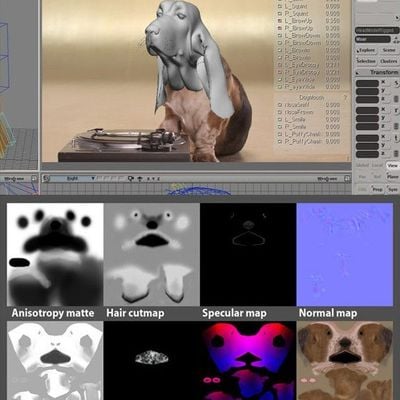

ICE trees can become pretty complex, so Softimage has added a great annotation tool.

Strands are great for creating grass, hair, seaweed, ribbons, light trails, fireworks, etc… and they can interact with other objects in the scene. They are continuous shapes generated at render time and cannot be manipulated in the way you would a scene mesh. These are solid trails that are drawn along a particles trajectory. While ICE can not yet create geometry but it can create what are known as Strands. It can generate cloth effects, control rigid body dynamics, flocking crowd effects and much, much more.

Textures, weight maps, the distance between objects, the color of a light, the current scene frame, the shape of an object etc… ICE can offset time on instances with animation. The effect can then be driven by a slider or just about anything. For example, it can connect to an extrude operator and push out polygons. If it's in the scene, ICE can connect to it and manipulate it. ICE is not just limited to particle effects either. So, if you've got an 8 core machine you won't have 7 cores idle while you wait. Feedback is very fast as it is 100% multi-threaded. Now, with ICE you can drop your particle animation into the animation mixer and stretch or squash your simulation till you get the proper results. In the past, this would require a re-simulation, reworking of the particle system or manipulation of rendered frames. For example, say you've created the perfect particle simulation but the client wants it slowed down or sped up. Once nice thing about ICE is that anything it generates can be accessed by any other area of the program. Opening up a compound is also a good way for users new to ICE to learn how everything works. These presets are actually compounds (more on that later) and can be "opened up" and modified to create totally different effects. While ICE comes with hundreds of operators, it also comes with more than 200 presets that anyone can drop into the scene so they can start working immediately. But just knowing that Softimage is working to expand ICE into other areas of the program is very exciting.

(At the moment you can only read them.) You've got to adjust an environment variable to get to it, thus opening yourself up to the possible instabilities caused by an unsupported feature. Additionally, there is a hidden feature that allows ICE to write to kinematics. Since pretty much any point data can be manipulated with ICE it can create a lot more effects that most people would not think to put in those two categories. Technically ICE can only be used to create particle effects and deformations, but that's an oversimplification. Networks of these nodes can get data from the scene, modify and process it to create tools which can then be used to generate all sorts of effects and changes to the scene. It allows you to use nodes to create interactive tools via a visual programming interface called the ICE Tree. (A node based material creation tool.) Formerly named Moondust, ICE is similar in that it is also a node based tool that allows you to build an effect from scratch, using very basic nodes (for atomic-level control) or higher level (pre-built) nodes to create something relatively complex in a much shorter time. If you are familiar with XSI, then you've most likely used the render tree. What is ICE? It's an "Interactive Creative Environment" that can be used to create effects and tools. However the one that seems to stand out the most is called ICE. Updates and new features have been added to just about every major aspect of the software. A new version of Softimage|XSI has arrived and from the looks of this release the crew working on it appear to have been very, very busy.


 0 kommentar(er)
0 kommentar(er)
